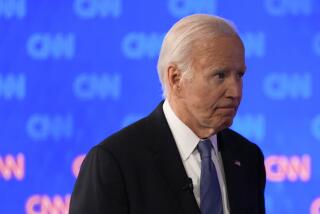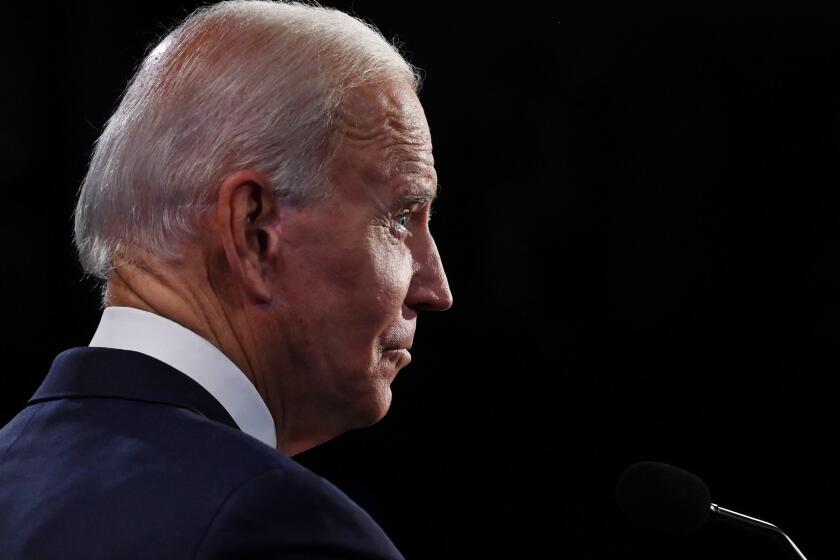Checchi Falls Behind Davis as Ads Backfire
Wounded by voter disgust over negative television commercials, businessman Al Checchi has plummeted in popularity and Lt. Gov. Gray Davis has taken over the lead as the race for the Democratic gubernatorial nomination heads toward election day, the Los Angeles Times Poll has found.
Checchi, who in a Times poll in April was tied for first among the Democratic candidates with U.S. Rep. Jane Harman, has dropped from 22% to 10% among likely voters, the survey found. At the expense of both Checchi and Harman, Davis surged ahead to win 28% of likely voters. Harman was picked by 16%.
Ahead of them all was the sole major Republican in the race, Atty. Gen. Dan Lungren, who is enjoying a surge of his own at 37%.
The newest Times poll underscores the exceptional volatility of this year’s governor’s race. At times, all three of the Democrats have held the lead, as voters scurry from one to another in search of the right fit.
Checchi’s breathtaking drop was fueled at least in part by the harshly negative tone his campaign adopted last month, when he began airing ads that were critical of the two other Democrats. Nearly half of all likely voters said Checchi has run the most negative campaign, and only 6% of those said they would vote for the political neophyte.
Checchi’s tactics have clearly alienated his own party and other groups as well. In hypothetical matchups for November’s general election, Lungren pulled ahead of Checchi 44% to 37% among registered voters, a reversal of their positions a month ago. In part, the turnaround occurred because Lungren now is capturing 27% of the potential November Democratic vote. Checchi now is seen in an unfavorable light within his own party and, stunningly, is tied with the Republican Lungren among Democrats likely to vote in June, the poll showed.
The high-wire approach Checchi has adopted in his self-financed quest for political office was evident. Strategically, his campaign has targeted Latinos, younger voters, independents and poorer voters, as well as Republicans. The first four groups tend to vote less regularly, and the last has increasingly turned to its own party’s candidate, Lungren.
Checchi’s support is far lower among likely voters--as determined by a variety of factors--than among all registered voters. When registered voters are measured, Davis still holds the lead among the Democrats at 24%, but Checchi and Harman are virtually tied at 17% and 15%, respectively. Lungren commands 28% of registered voters.
Although Checchi could improve his standing with a ferocious effort to bring marginal voters to the polls, Times Poll Director Susan Pinkus said he has clearly harmed himself.
“He made a good first impression when people were shopping around,” Pinkus said. “After a closer look, they have decided that he’s not the candidate for them. People want experience in government. And people believe that he is the one instigating the negative ad war.”
From May 16-20, the Times Poll interviewed 1,097 registered voters in California, including 506 voters considered likely to cast ballots. The margin of sampling error for registered voters is 3 percentage points in either direction; the margin for likely voters is 5 points in either direction.
The four leading candidates from both major parties were measured together because they will all appear on the same ballot, under the state’s new blanket primary system. Voters will be able to choose any candidate, regardless of party registration.
The poll demonstrates not only the dangers of a strongly negative campaign but also the strength of a patient and disciplined one. Davis has for months been the tortoise in a field of hares, out of financial necessity holding off his advertising while Checchi bombarded the airwaves.
When he did begin running ads, Davis ended each with a tag line needling his opponents for their millions--”Experience Money Can’t Buy.” That slogan resonated with voters, Pinkus said. When asked whether they preferred a candidate with business experience, political experience or some of both, more than half of registered voters and likely voters sided with political experience--a profile Davis fits best. The number preferring an outsider from the business world--in other words, Checchi--has fallen to 21% among registered voters and 18% among likely voters.
Checchi’s negative standing was in stark contrast to Davis’ positive hold on the electorate. Among likely voters, 66% held Davis in a favorable light, as did 56% of registered voters, 62% of registered Democrats and even 54% of registered Republicans. Checchi, in contrast, was considered favorably by only 37% of registered voters--and 36% of Democrats, down from 50% in April. He fell from 49% among registered Republicans in April to 34% now.
Additionally, voters said they trust Davis, ahead of all the other Democrats, to handle pressing state issues such as education, crime and the economy.
On education--by far the most important issue to Californians this election year and one Checchi has emphasized for many months--Davis trounced the businessman. Twenty-seven percent of likely voters, and 22% of registered voters, said they consider Davis the best equipped to handle education.
Lungren and Harman tied for second among likely voters with 22% and carried 16% and 17% of registered voters, respectively. Checchi was last, with 9% of likely voters and 14% of registered voters believing him best able to handle the issue.
Checchi did better when it came to the economy, but only marginally. On that issue, 27% of likely voters said Davis is best, followed closely by Lungren at 25%. Checchi carried 20% and Harman 11%.
Lungren, currently the top law enforcement official in the state, maintained the traditional Republican hold on the issue of crime as 48% of likely voters declared him best on that issue. Davis was second at 23%, and Harman and Checchi virtually tied at 7% and 6%, respectively.
Lastly, asked which candidate better understands “people like you,” Lungren, Harman and Davis were closely bunched among likely voters at 26%, 25% and 23%, respectively. Checchi, who has a net worth of more than $700 million and has spent more than $30 million of his money on the race, was a distant fourth at 5%.
In all cases, Checchi did better when all registered voters were taken into account. But because his voters are not as probable as the others’ to actually cast ballots, he fell among likely voters. And Davis was strong in each category.
“People are voting for Davis because they want experience,” said Pinkus.
Harman’s campaign has sought to charge up the middle between Davis and Checchi. She also has tried to reap benefits from Checchi’s negativity, professing that she will run a positive campaign.
But she has clearly not found a lasting niche. Among likely voters, for example, she dropped 8 points in the last month, from 24% to 16%.
Gender Differences
Even among women, on whose votes Harman is depending, she is running behind. The poll was taken, however, before Harman won the endorsement of U.S. Sen. Dianne Feinstein, one of the state’s most popular politicians and one Harman hopes will pull women to her side.
Among all women, Lungren commanded 37% of likely voters, Davis 25%, Harman 19% and Checchi 9%. Harman and Checchi were essentially tied for last among registered female voters, with 17% and 15%, respectively.
Interestingly, although Republicans generally run better among men, Lungren’s percentage among men likely to vote was an equivalent 38%, to 32% for Davis and 11% for Harman and Checchi.
Harman’s standing improved among Democratic women likely to vote, who according to political tradition should be her strongest allies. But she continued to trail Davis slightly in that category by 38% to 34%, with Lungren at 10% and Checchi at 7%.
Among likely male Democratic voters, a gender gap became evident. There, Davis held a strong lead, 43% to Harman’s 17%, with Checchi at 15% and Lungren 2 points behind him. Republican women were not leaning toward Harman. By far, most Republicans of both sexes went to Lungren; only 5% of likely GOP male voters and 3% of likely GOP women voters went to Harman.
Overall, Pinkus said, “Harman is not getting a lift from being a woman.”
Still, she fared generally better than Checchi. His precipitous decline spanned the range of political ideologies, suggesting that voters overall have simply tired of him after a relentless six-month advertising campaign, much of it negative in recent weeks.
Among likely conservative voters, he carried a mere 6%, down from 20% in April. Lungren led among conservatives with 60%, followed by Harman and Davis at a distant 13%.
Among likely liberal voters, Checchi held 18%, down 6 points from April. Davis commanded that group with 41%, to Harman’s 25% and Lungren’s 10%.
Among moderates, which Checchi had targeted, he carried a flimsy 9%, down from 21% in April. Davis also controlled this group, with 37% to Lungren’s 27% and Harman’s 13%.
The standings make it clear that Democrats have thus far failed in their attempts to demonize Lungren, efforts that have taken a back seat to their most pressing efforts to crush one another.
He rose 9 points between April and May among likely voters, from 28% to 37%. Not only is Lungren holding his own among middle-of-the-road voters, but he is also strengthening himself in hypothetical matchups for November. He reversed Checchi’s hold over him, running 44% to 37% over the businessman among registered voters now, compared to losing 47% to 37% in April.
Lungren also improved his standing against Harman, raising himself to a 42%-42% draw compared to her 44%-39% margin in April’s poll. Against the surging Davis, however, Lungren fell further behind, with a 16-point margin (51% to 35%) in Davis’s favor, compared to 12 points in April.
Among their own voters, of course, each of the candidates had strengths.
Among Davis voters, 40% cited his experience as a factor in their decision to vote for him, an indication that his commercials have worked. Sixteen percent said they agree with his stands on the issues, and the same percentage described him as the best candidate.
Many of Harman’s voters said they agree with her stand on the issues--34%--while 21% said they side with her because she is a woman and 13% said she is the best candidate. Among Checchi partisans, 23% cited his views on the issues, 19% specifically citing his stance on education. Sixteen percent said he is the best candidate.
For Lungren, the putative GOP nominee, his party was enough for many--25% said they would vote for him because he is a Republican. Twenty-four percent agree with him on the issues and 18% said he is the best candidate.
One way or another, however, it appeared that Checchi’s strategic decision to bombard his opponents with negative ads has backfired on him. Among likely voters, 45% said he has run the most negative campaign. The closest competitor was “all of them,” with 21%.
Only 7% said Harman, whose ads have only glancingly referred to her opponents. Davis, who has been negative, escaped relatively unscathed, with only 3% saying he has been. That was an indication, Pinkus said, that voters excuse attacks they see as retaliatory.
The fallout for Checchi is clear. Among likely voters who think he is the most negative, his 6% standing is a distant fourth to 40% for Davis, 30% for Lungren and 17% for Harman.
Comparatively, those who think all the candidates have been negative excused Checchi and were far more supportive of him. Forty-three percent of them sided with Lungren, 16% with Checchi, 22% with Davis and 7% with Harman.
Checchi has defended his ads as legitimate candidate comparisons, and said that he is only responding to a flurry of criticisms by other candidates, particularly Davis. Since none of those criticisms were included in television commercials, however, Checchi appears to voters to be striking the first blows.
“That negativity,” Pinkus said, “is what is bringing his numbers down.”
(BEGIN TEXT OF INFOBOX / INFOGRAPHIC)
THE TIMES POLL: The People’s Choice
Fed up with negative advertising, voters have taken out their anger on Democratic Al Checchi, whose standings in the Los Angeles Times poll have slipped among likely voters from 22% in April to 10% now. Lt. Gov. Gray Davis is benefiting from the businessman’s fall, and from a slump by the third major Democrat, U.S. Rep. Jane Harman of Torrance. Republican Dan Lungren, the state attorney general, has strengthened his hand with less than two weeks to go before the primary election.
ON THE RISE: Gray Davis, Dan Lungren
FALLING BACK: Al Checchi, Jane Harman
*
For whom would you vote if the June primary were held today and the candidates were:
*--*
April Now Lungren 28% 37% Davis 13% 28% Harman 24% 16% Checchi 22% 10% Don’t know 13% 9%
*--*
*
For whom would you vote if the general election were held today and the candidates were: (Among registered voters)
*--*
Now April Checchi 37% 47% Lungren 44% 37% Davis 51% 48% Lungren 35% 36% Harman 42% 44% Lungren 42% 39%
*--*
*
Which candidate for governor has run the most negative campaign?
*--*
Registered Likely voters voters Checchi 32% 45% Harman 7% 7% Davis 3% 3% Lungren 2% 3% All equally 25% 21% None 8% 7% Don’t know 23% 14%
*--*
*
What is your impression of: (Among registered voters)
*--*
Lungren Checchi Davis Harman Favorable 46% 37% 56% 38% Unfavorable 23% 42% 18% 32% Haven’t heard/ Don’t know 31% 21% 26% 30%
*--*
*
Which candidate for governor would you prefer?
*--*
Registered Likely voters voters One who has never held elected office but has had business career 21% 18% One who has had years of experience in elected office 52% 51%
*--*
Numbers may not total 100% where some answer categories are not shown.
****
HOW THE POLL WAS CONDUCTED
The Times Pol contacted 1,514 California adults, including 1,097 registered voters and 506 likely voters, by telephone May 16 through 20. Telephone numbers were chosen from a list of all exchanges in the state. Random-digit dialing techniques were used so that listed and non-listed numbers could be contacted. The entire sample was weighted slightly to conform with census figures for sex, race, age, education, region and registration. The margin of sampling error for the entire sample and registered voters is plus or minus 3 percentage points; for likely voters it is 5 points. For certain subgroups the error margin may be somewhat higher. Poll results can also be affected by other factors such as question wording and the order in which questions are presented. Interviews were conducted in English and Spanish. Times Poll results are also available on the World Wide Web at https://www.latimes.com/HOME/NEWS/POLLS/.
More to Read
Get the L.A. Times Politics newsletter
Deeply reported insights into legislation, politics and policy from Sacramento, Washington and beyond. In your inbox three times per week.
You may occasionally receive promotional content from the Los Angeles Times.







